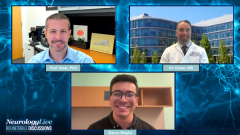
Defining Remyelination in the Context of Multiple Sclerosis
In this initial episode, experts Ari Green, MD, and Paul Tesar, PhD, break down the biological foundation and therapeutic importance of remyelination in multiple sclerosis.
Episodes in this series

Despite major advancements in the treatment of multiple sclerosis (MS), including the emergence of highly effective disease-modifying therapies that target inflammation and reduce relapse rates, there remains a critical unmet need: the ability to repair damaged myelin. Remyelination—the process by which the central nervous system regenerates myelin sheaths around axons—is a key neuroprotective and potentially restorative goal in MS. While spontaneous remyelination can occur, particularly early in the disease, it is often incomplete and declines over time, contributing to irreversible neurological disability.
In recent years, an influx of research has significantly advanced our understanding of the biology of remyelination, uncovering new molecular targets, cellular mechanisms, and imaging modalities. Yet, despite promising results in preclinical models, there are still no FDA-approved therapies that directly promote remyelination. In this panel discussion, Ari Green, MD, and Paul Tesar, PhD, examine the evolving landscape of remyelination science—highlighting the translational challenges, trial design hurdles, and promising agents in development—while offering insights into the future of regenerative strategies in MS care.
In this opening episode, Ari Green, MD, and Paul Tesar, PhD, explore the fundamentals of remyelination in MS and how recent advances have shaped our understanding of this process. The discussion highlights the biological importance of restoring myelin, the role of oligodendrocyte progenitor cells, and why remyelination is emerging as a key therapeutic target in MS care.
Transcript edited for clarity.
Marco (Moderator): The first topic we’ll jump into is more foundational: What is remyelination in the context of multiple sclerosis, and how has our understanding of it evolved through recent research advances? I’ll open the floor.
Ari Green, MD: Remyelination in MS refers to the restoration of normal—or near-normal—myelin architecture, the insulating substance around nerve fibers in the brain. It’s a critical step not only in recovering function but also in preserving it over the long term. Our understanding of remyelination has evolved significantly. There's a lot of nuance in replicating the myelin as it was originally formed during development—how many wraps of myelin are present, the spacing between myelin segments, and many other features that influence function. We're still learning how activity modulates myelination, and this remains a key area for ongoing research. I’ll let Paul build on that.
Paul Tesar, PhD: One major point is that failure to restore myelin deprives neurons of critical support. This contributes to progressive neurodegeneration in MS. Remyelination is unequivocally neuroprotective and should be viewed as a critical therapeutic pillar—not only in MS but also in other neurodevelopmental and neurodegenerative diseases. Another essential concept is that remyelination generally requires the generation of new oligodendrocytes from progenitor cells. Enhancing remyelination means we need to stimulate these progenitor cells to form new oligodendrocytes, which then produce new myelin. That’s an extraordinary biological capacity—there are very few human cell types with this innate ability to regenerate after injury. These cells represent a unique and promising therapeutic target.
Ari Green, MD: Paul’s point is critical: this is truly a unique regenerative capacity in the brain. The ability to catalyze the brain’s inborn repair mechanisms is a remarkable opportunity. It sets the stage for broader approaches to neurological repair and is a necessary step on the path toward meaningful regeneration and recovery.
Newsletter
Keep your finger on the pulse of neurology—subscribe to NeurologyLive for expert interviews, new data, and breakthrough treatment updates.





































